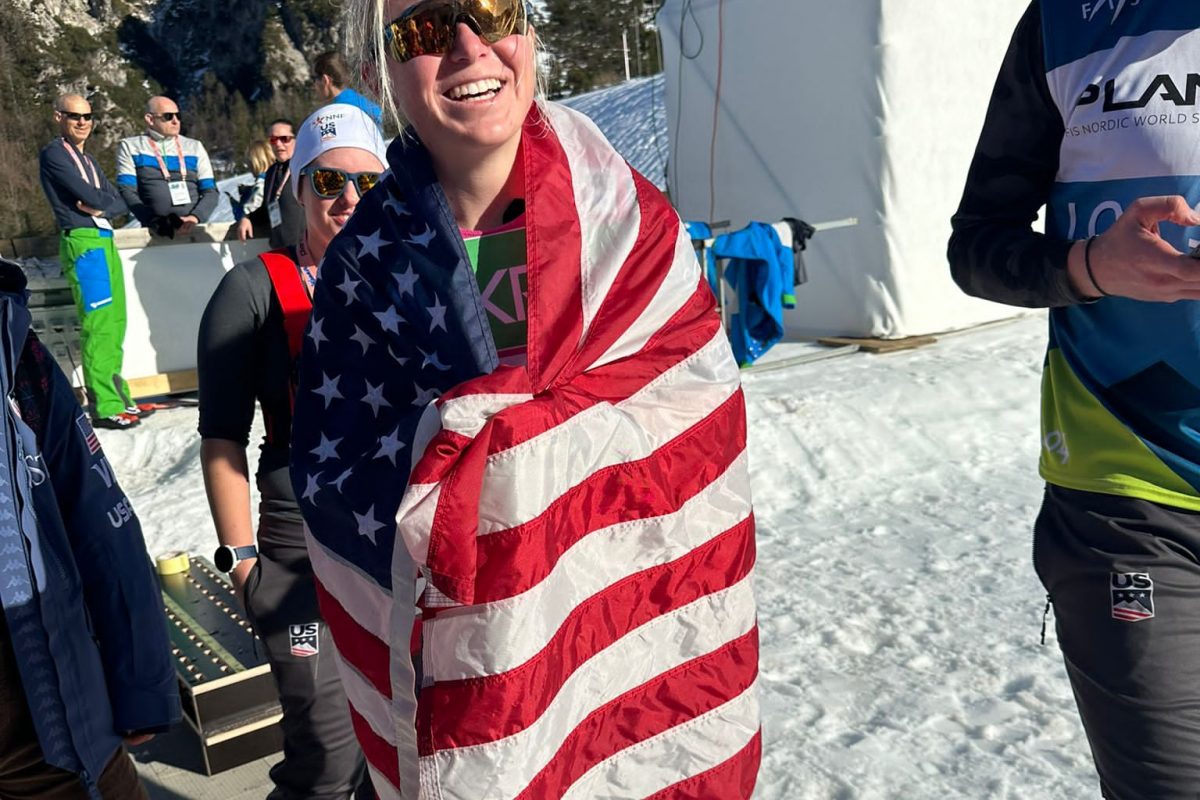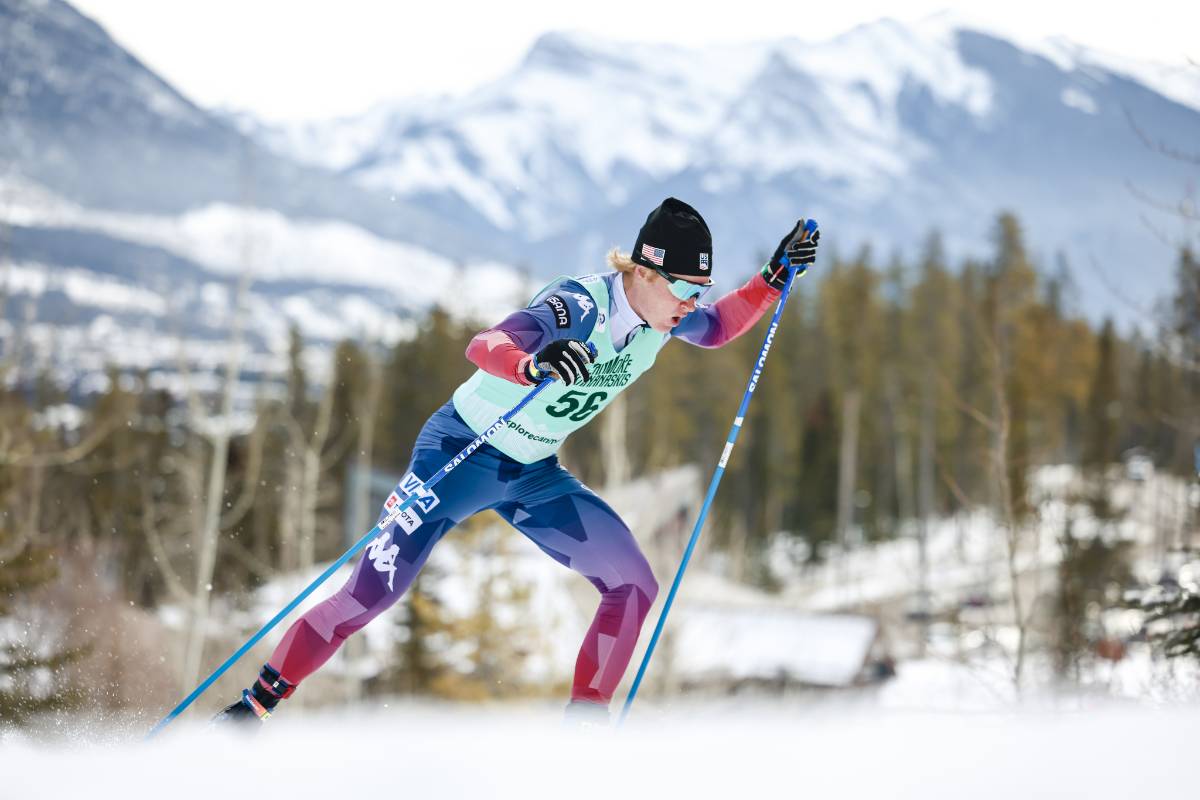
The story of how Colby College became the Mules traces back to years of listless play from their football team, before a season in which the team suddenly became one of the best in New England. That led the Sports Editor at the student newspaper, The Colby Echo, to remark that instead of “black horse” to win their conference, Colby was suddenly a “white mule.” A couple of creative undergrads took the cue, sourced the rural environs around Waterville, Maine, and the next weekend, a real live mule patrolled the Colby sideline.
A century later, the story seems allegorical for the story of Colby nordic skier Jack Young. The Jay, Vermont native and Colby Junior spent his winter chasing down World Cup starts as one of the country’s best sprint prospects. Then, in his first World Cup start, Young quickly put together a memorable performance in Canmore where he qualified for the skate sprint heats in 11th place. In retrospect, it pointed to the potential of American skiers to leverage the relative home-field advantage of a rare North American World Cup tour into expectation-defying results. A week later, Gus Schumacher won in Minneapolis. Black horse to white mule-type stuff.
Earlier this month, as the buds of spring emerged on Colby’s Mayflower Hill campus, Jack Young’s performance proved to earn him a nomination to the D-Team of the Stifel U.S. Ski Team. He is the first Colby skier to receive a nomination while still enrolled at the small college of 2,200 undergraduates in Central Maine.
Young’s Colby College affiliation stood out among a nominee sheet that includes storied collegiate ski programs with more Team USA alumni in their history than one can count: University of Vermont, Dartmouth College, University of Utah, University of Alaska-Fairbanks, and University of Alaska-Anchorage, among others. Young qualified for the team via objective criteria requiring him to be ranked in the top 175 skiers in the World in his birth year, a standard that speaks to his accomplishments as an athlete, and his embracing of a Colby College ski-culture that revels in the role of offbeat outsider.
A Whole New World…Cup
When Young woke up on the morning of his World Cup race in Canmore, he was focused on feelings more than results. “Once I got a World Cup bid, my complete focus changed to getting to the place that I race best, which is not just physically being rested, but in a place where I have carved out the space in my mind to just get excited to ski race.” When he finally got to ski the sprint qualifier, that feeling transformed into something like euphoria, “I hit the top of the course, and all I was focused on from there was riding the wave I got from imagining that moment and reaching it,” he said. “I didn’t have a thought of where I might stack up in the field. I think that’s when the qualifier fell into place for me.”
As Young crossed the line, where he was stacking up in the field came into view for everyone; it simply astounded. “[American] Murphy Kimball was in the finish corral and was cooled down enough to be processing what the announcers were saying, which I wasn’t, and he heard ‘Jack Young, in 11th,’ and just immediately looked at me. So I stare back for like three seconds of silence, and then he just gives me the biggest hug ever. I started to get it then.”
Young had just started to process his achievement as others looked on with a mixture of awe and dis-belief. “My sister texted me asking if the result on the FIS App was correct.” His Colby teammates, camped up in Hanover, New Hampshire at the EISA Dartmouth Carnival also quickly got in contact. “They were like, it’s not just us that’s excited for you, EVERYONE here is excited.”
Meanwhile, Colby Head Coach Tracey Cote, was spelling it out in even more plain terms. In response to a text that said, “Mules in the Heats,” her response was an exuberant, “HOLY S***!” For Cote, the moment was a culmination of what she has always coached towards: not just an athlete reaching a goal they’ve worked at for years, but doing so in a way that reflected the unique intersection that happens when an athlete brings the character qualities they hold as a person to performing in the ever-complex sport of nordic skiing. “He started thinking about wanting to qualify for the World Cup in the summer,? said Cote. “And from that point forward, everything he did in training and life was centered around this goal.”
Looking back, Young sees Cote’s philosophy as key to his preparations to excel at the sport’s highest level. “She will always say, ‘[at Colby] we coach skiers, not just skiing’ and I think it took me a little bit to understand that,” said Young. “But I look at Canmore, and I think about how I was prepared to ski as well as I did. It wasn’t just because my training was good. It wasn’t just that I was physically rested. It was because I went in trusting that if I carried myself how I know I can carry myself, ski how I know I can ski, things would fall into place. I don’t get that without Tracey, or my teammates working everyday towards a culture that empowers that.”
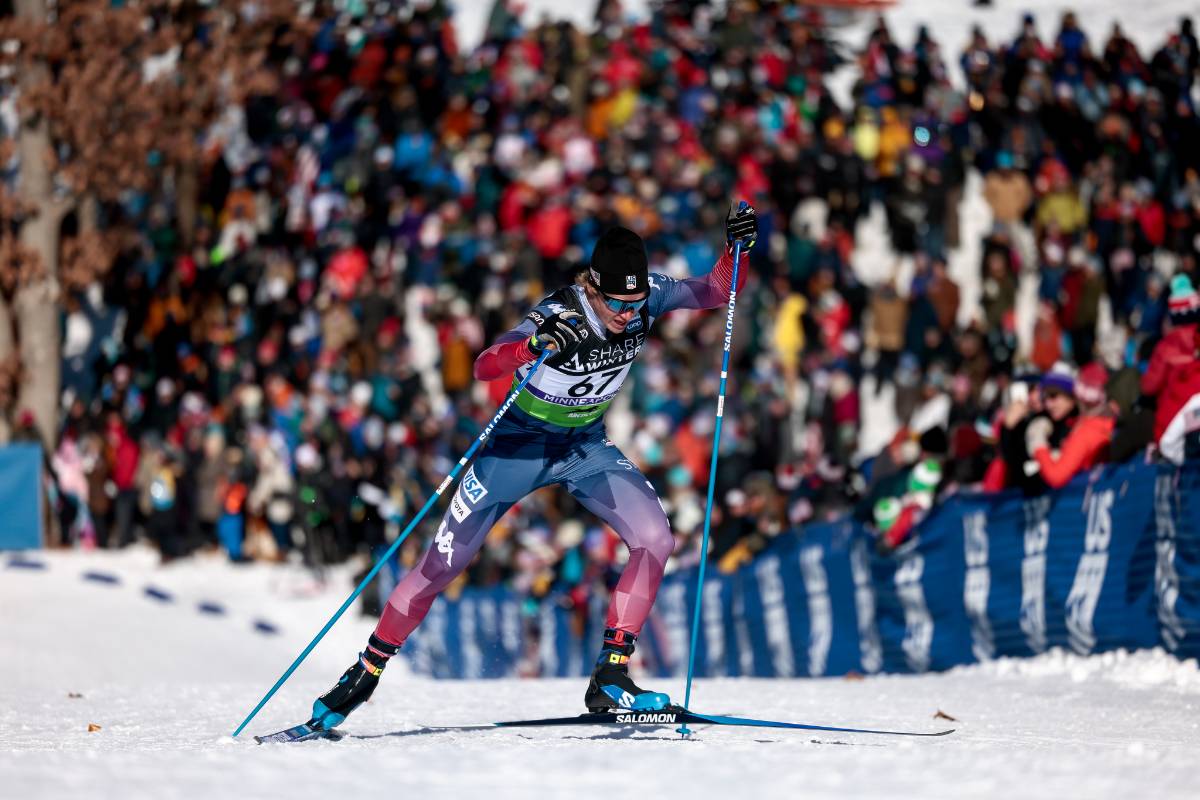
To Cote, Young’s results on the World Cup and throughout the season were evidence of his personal capacity to be “exceptionally collaborative.”
“We meet constantly to talk about how we can incorporate what he needs into the team training and when he just needs something different,” said Cote. “I have so much respect for skiers who can achieve incredible results while also lifting up their teammates. Not every top-level skier can do this, but I have been lucky to coach a few in my career and Jack is definitely one!”
Cote and Young also have cued in on Young’s profile as a skier acting as a litmus test for the team-forward culture at Colby. The NCAA circuit in which Colby competes has traditionally been focused on distance-only racing. Young, who earned his World Cup bids on his sprinting ability, has needed to create a training and racing calendar that can look very different from that of his Colby teammates.
“The coolest thing about training at Colby is that in any given workout, one of our guys can do something special,” said Young. “I hope that in a sprint workout, guys like Zach [Nemeth] can push themselves off me, and in a distance workout, I learn a lot from Zach, and the others too.”
Still, there are times when Young strays to keep sharp for sprinting. “He is so intentional about not disrupting the team culture,” says Cote. “Everyone understands when Jack does a different workout.” Young too, has seen it as a would-be weakness that’s turned into a key strength for the Colby team. “The thing about our season is that we have all fall as a team to work out any tension around individualized plans,” Young explained. “When we hit winter, we’re all in lockstep, the whole team, and better for it.”
The process of creating a team culture comes with a necessary constraint in NCAA skiing that Young looks at as a continuing opportunity. “The reality is the team is different every year, because you lose guys to graduation, and you have freshman that come in. Which again, [what you] try to do is turn what might be a weakness into a strength. Every fall, we’re looking to create a team that’s going to work best for that season.”
With that challenge of creating a culture ahead of him for one more year, Young eagerly anticipating the opportunity. “I get to bring the World Cup experience back, that’s exciting.”

For Young, that’s the triumph of his sprint qualifier just as much as his “welcome to the Big Leagues” moment that came in his sprint heat at Canmore. In a heat with eventual World Cup champion Harald Oestberg Amundsen (Norway) and World Championship sprint medalist Jules Chappaz (France), he was competitive, but eventually lost ground in the final surge. “I’d talked [the heat] over with the US Team coaches, and we both agreed with it being my first time going in and trying to stay relaxed, [but] the reality of those World Cup heats is that being ‘relaxed’ per se means still jockeying for a good position so that when the heat goes…and they GO…you can react quick enough to adjust to the pace.”
Young sees the experience as a necessary learning ground, and knows what to adjust going forward. “I can’t wait to bring that back to training,” he said. “The idea that when you enter a World Cup heat, everyone thinks they can be in the top two in that heat. To me, that’s an attitude I need to have, and I want all my teammates to have too.”
Cote has no doubt those new lessons will combine with Young’s steady leadership. “He’s been a leader sine the day he stepped foot on our campus and always brings a level of positive and competitive spirit that infuses confidence into his teammates.”
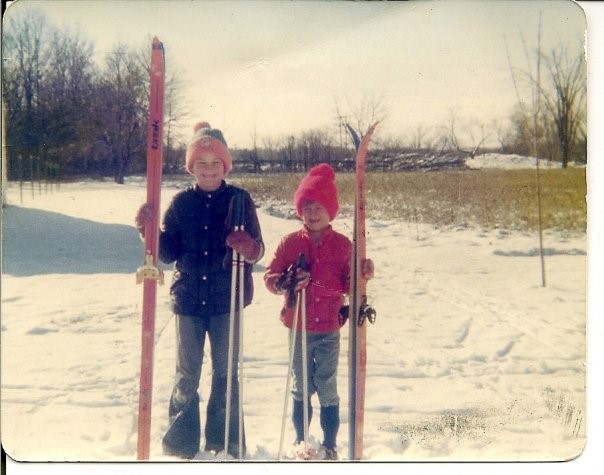
A Match Made in Waterville, Maine
The success Young had this season may seem like the result of a serendipitous match with the Colby program. But for longtime observers, Young’s nomination to the Stifel US Ski Team is the logical outgrowth of a program built steadily over generations.
All great programs bear traces of their leaders. For Colby, that’s found in Tracey Cote, who has served as Head Coach for 27 seasons. Cote (née Theyerl—note the non-coincidental author’s byline of this article) grew up in the small Wisconsin village of Elkhart Lake, an hour and a half into the hills north of Milwaukee. Tracey and brother Ted took their first ski strides in the Schultz family cornfield behind their modest home on the outskirts of Elkhart Lake, and continued on into American Birkebeiners of the 1970’s. Her beginnings in the sport were literally out on the back forty.
Starting out skiing in the Kettle-Moraine forest was a far cry from the traditional skier development centers across the United States. Elkhart Lake-Glenbeulah High School certainly was not a ski academy. Fifteen miles west of Sheboygan wasn’t Aspen. Where Cote learned to ski, she learned to love skiing alone. When she did ski with others, it was a family affair. Those two elements continued through Cote’s own collegiate career at Northern Michigan University, her taking on the Colby program in its first year as a Division I ski program in 1997, and through NCAA Championship qualifiers, NCAA All-American finishers, World Junior Championship qualifiers, and now, a US Ski Team member. Her coaching is driven by a desire for every Colby skier to intensely pursue their own competitive skiing goals, while maintaining the perspective to intensely pursue relationships with their teammates, and the sport, that makes everyone feel supported. That’s a close approximation to the “team culture” often spoken about by Young and Cote. “Any one skier’s success is a success for everyone.”
That guiding principle has never come at the expense of letting some of Cote’s own background and quirks shine through. “Tracey will talk a lot about is how training is often a process of avoiding mistakes, more than finding a silver bullet,” says Young. “And that often translates into letting her athletes train on the terms that work best for them.
For years, Cote’s athletes have come from backgrounds in cycling, soccer, basketball, football, and even more esoteric pursuits. She also has a penchant for recruiting skiers who come from out-of-the-way talent centers, and keep to unconventional paths in the sport. The Colby program’s first World Cup skier under Cote came earlier this year when alumni Erin Bianco, who currently skis for Bridger Ski Foundation out of Bozeman, Montana, made her first World Cup starts in Oberhof, Germany. Bianco qualified for her first World Cup sprint heats on the same day Young put in his performance at Canmore. When Cote recruited the Iron Range, Ely, Minnesota native though, Bianco was out of skiing, running at St. Olaf College. Bianco transferred to Colby and became an NCAA All-American.
Further back, the Colby’s program milestones have been linked to out-of-the-way stories of success. Colby’s first All-American, Olivia Amber, came from the small outpost of Lake Nebagamon, Wisconsin, where she and her sister constituted the entirety of their high school team. Colby’s most dominant skier during Cote’s tenure, Zane Fields, was a Woodstock, Vermont skier who came direct from that state’s high school league. The program’s first World U23 Championship qualifier, Andrew Egger, was a sprint specialist who was concurrently enrolled in Officer Training School for the US Marine Corps.
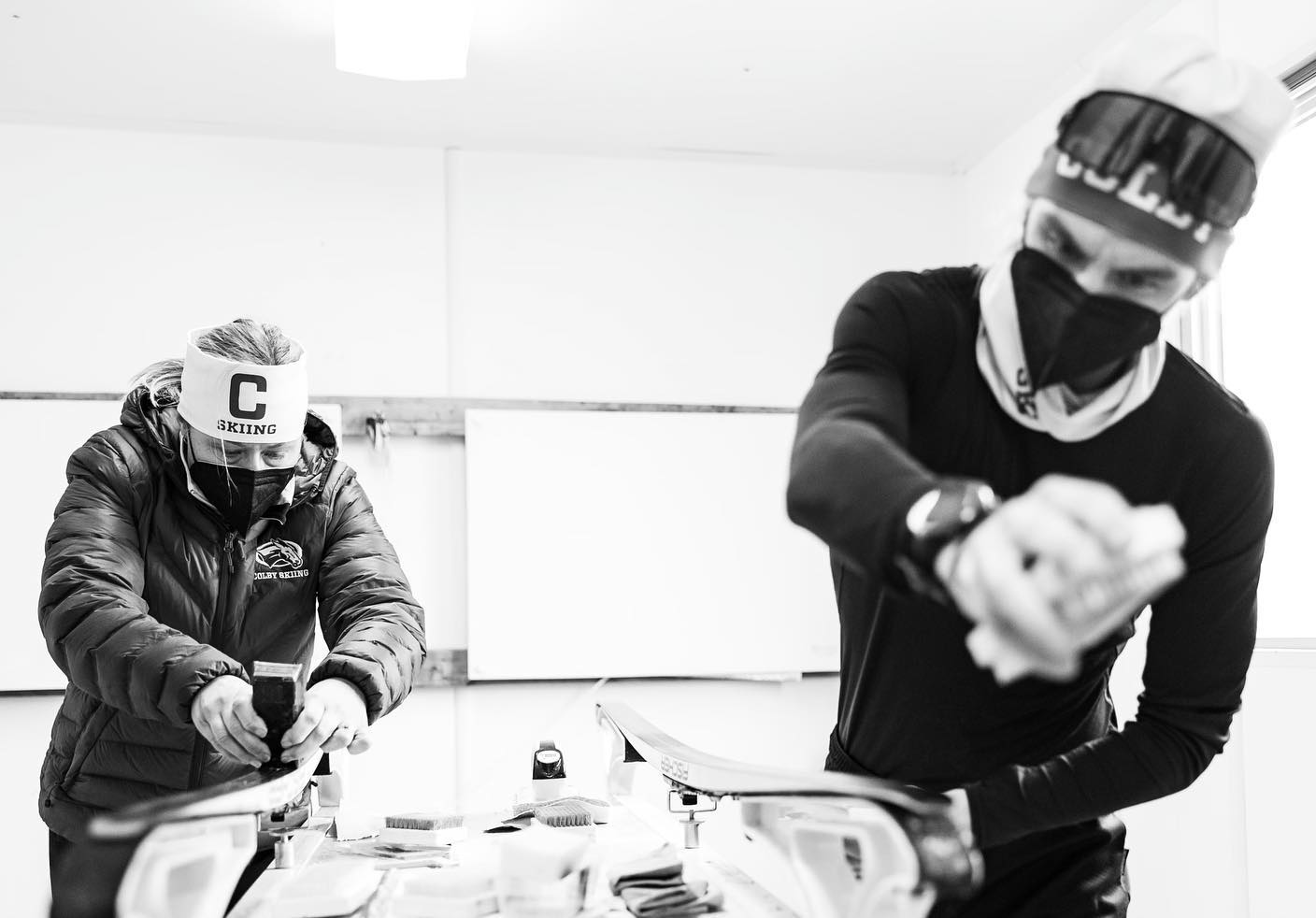
They all have come to Waterville, a post-industrial New England mill town in central Maine where they found an out-of-the-way approach to pursuing the sport at the highest level. Cote and Colby have made sure those skiers have all the resources to do so. A decade ago, Colby partnered with the town of Waterville to revive and expand an abandoned quarry, Quarry Road, down the hill from campus into a homologated 5 k course with snowmaking. Two years ago, Colby opened a $200 million-dollar athletic center boasting a full support staff, and arguably the best waxing facilities in the East. For Cote, there was a clear direction in the investments: “It’s made us an attractive place to support a collegiate ski career.”
All of which sets up to point towards an understanding of why Jack Young has not just excelled as a skier, but excelled as a Colby skier. Young has been nordic skiing since he was a little kid in Jay, Vermont’s Bill Koch Youth League (BKL). He didn’t connect with the sport competitively though until relatively late, joining up with the nearby Craftsbury Ski Club in high school. By then, he was more known around Vermont’s Northeast Kingdom as his high school’s starting quarterback than as a top junior skiing prospect.
He found success, becoming a Vermont State Champion skier five times over. However, he still went relatively under the radar to the college coaches casting a recruiting net over a national pool of skiing talent. In short, Young was a bit of an outsider going into college. Which made him the type of skier with whom Cote has had success in her tenure.

Young admits that his current list of accomplishments is something that he didn’t even fathom at this time last year. “This season was a sequence of things that just kept going,” he said. “I didn’t take that for granted, but I did have to learn to take it. You go from dreaming of winning a SuperTour qualifier, then you do it like I did in Anchorage, and then you start piecing things together from there. Oh, I could make the World Cup. Oh, I made the World Cup…things like that. I guess the US Ski Team is that too.”
His nomination to the Stifel U.S. Ski Team is something that both he, and the program he comes from, see as the realization of the groundwork laid over the course of decades. “I’ve always loved skiing,” he said. “But really I think the difference has been that I learned to love the competition and training aspect of skiing. When I was a kid in the BKL, it wasn’t on the forefront of my mind to compete on the world stage. Now it is.”
In Jack Young, the skier, there’s a parable for a program. No longer the black horse, with Young, the Colby mules are kicking on.
Ben Theyerl
Ben Theyerl was born into a family now three-generations into nordic ski racing in the US. He grew up skiing for Chippewa Valley Nordic in his native Eau Claire, Wisconsin, before spending four years racing for Colby College in Maine. He currently mixes writing and skiing while based out of Crested Butte, CO, where he coaches the best group of high schoolers one could hope to find.



